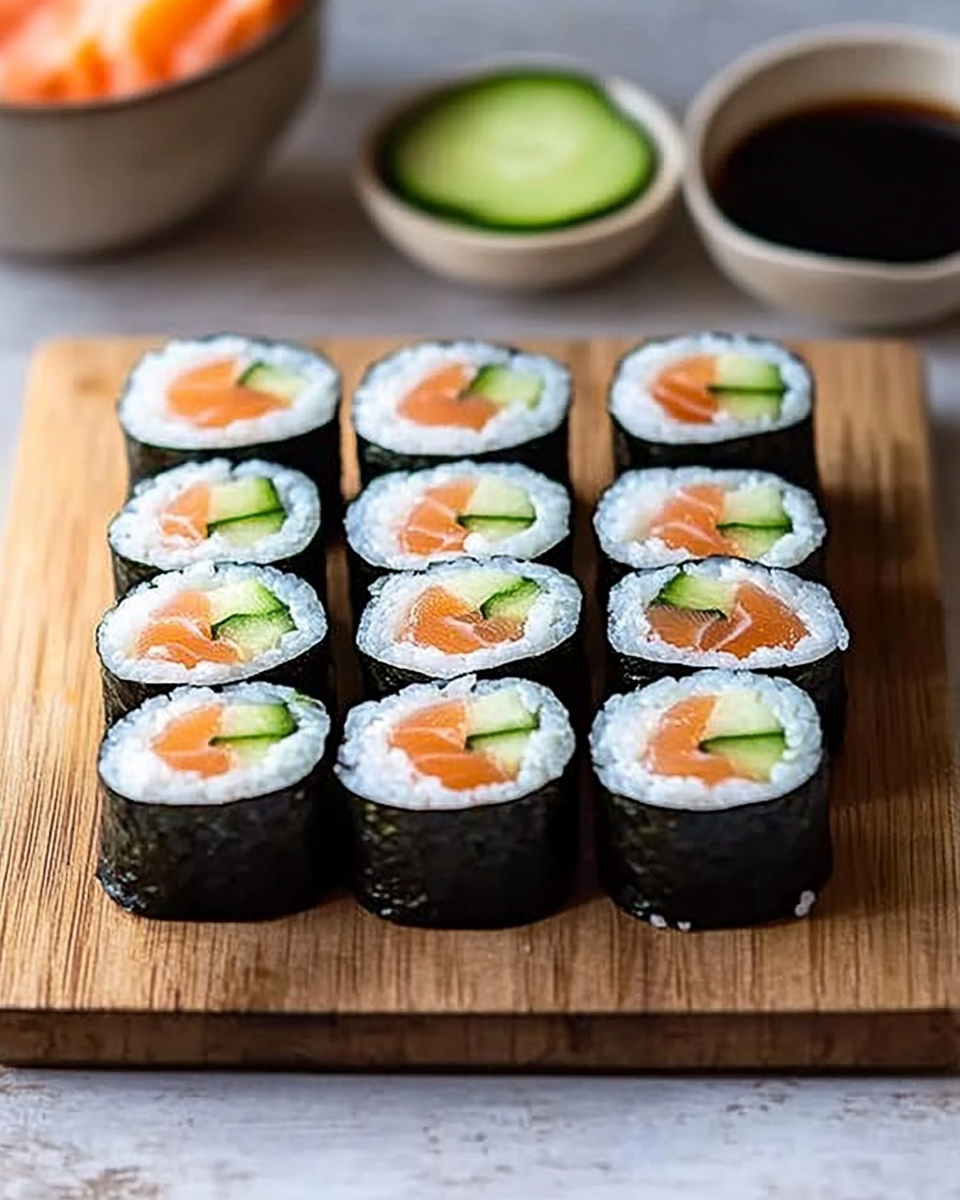Maki sushi, with its vibrant rolls and delicate balance of fresh fish, vegetables, and rice, is a quintessential Japanese dish that offers both flavor and artistry. The sushi rice, seasoned with vinegar, sugar, and salt, pairs perfectly with the freshness of the fish and crunchy cucumber. The nori wraps it all up, offering an umami-packed flavor with each bite.
This dish is versatile and can be easily tailored to your tastes, whether you prefer a traditional roll with tuna or a vegetarian option with cucumber and avocado. Perfect for a fun family dinner or a sushi-making night with friends, maki sushi is a simple yet impressive way to enjoy Japanese cuisine at home.
Full Recipe:
-
2 cups sushi rice
-
2 1/2 cups water
-
2 tablespoons rice vinegar
-
1 tablespoon sugar
-
1/2 teaspoon salt
-
10 sheets nori (seaweed)
-
1/2 lb sushi-grade fish (salmon, tuna, or your choice)
-
1 cucumber, julienned
-
1 avocado, sliced
-
1/4 cup pickled ginger
-
Soy sauce, for serving
-
Wasabi, for serving
Directions:
-
Rinse the sushi rice in cold water until the water runs clear.
-
Combine the rinsed rice and water in a pot. Bring to a boil, then reduce to a simmer, cover, and cook for 15-20 minutes, until all the water is absorbed.
-
In a small bowl, combine rice vinegar, sugar, and salt, stirring until dissolved. Once the rice is done cooking, let it cool slightly and mix the vinegar mixture into the rice.
-
Place a sheet of nori on a bamboo sushi mat, shiny side down. Spread a thin layer of rice over the nori, leaving about 1 inch of nori at the top.
-
Lay the fish, cucumber, and avocado slices in a line across the center of the rice.
-
Roll the sushi tightly using the bamboo mat, starting from the bottom. Use a little water to seal the edge of the nori.
-
Slice the roll into bite-sized pieces using a sharp knife.
-
Serve the maki sushi with soy sauce, pickled ginger, and wasabi.
Prep Time: 20 minutes | Cooking Time: 20 minutes | Total Time: 40 minutes
Kcal: 300 kcal | Servings: 4 servings
The Art of Maki Sushi: A Traditional Japanese Delight
Maki sushi is a celebrated dish that has won the hearts of sushi lovers worldwide. With its crisp nori, seasoned rice, and the variety of fillings, it’s a beautiful fusion of flavors and textures. Whether you’re a sushi connoisseur or a beginner, maki sushi remains a delightful treat, known for its simplicity and versatility. In this article, we delve into the rich history of maki sushi, its many variations, health benefits, tips for making it at home, and creative ways to serve it. By the end, you’ll have a deeper appreciation for this iconic Japanese dish.
The History of Maki Sushi
Sushi, in general, has been a part of Japanese cuisine for centuries. Its origins trace back to the 8th century, where fermented rice was used to preserve fish. Over time, sushi evolved from this preservation technique into the flavorful dish we enjoy today. Maki sushi, specifically, became popular during the Edo period (1603–1868). The tradition of rolling fish and vegetables in rice and nori (seaweed) began to take shape as a convenient and easy-to-eat form of sushi.
During the Edo period, sushi chefs in Tokyo (formerly Edo) created “edomae sushi,” which focused on fresh fish and quick preparation methods. Maki sushi was initially a simple street food, often enjoyed by the working class. However, as the popularity of sushi grew, different variations of maki sushi were created, incorporating various fillings and flavors. This shift from a humble street snack to a celebrated dish marked the beginning of maki sushi’s rise to global fame.
Types of Maki Sushi
Maki sushi comes in different forms, each with its unique presentation and flavor profile. The most common types of maki sushi are:
1. Hosomaki: These are the classic and most traditional maki rolls. They are small, bite-sized rolls made with a single filling, usually cucumber, tuna, or salmon. The ingredients are rolled tightly in a sheet of nori with sushi rice on the inside.
2. Uramaki: Unlike the traditional maki rolls, uramaki is known for having the rice on the outside of the nori. The rice is sprinkled with sesame seeds or fish roe to give it an extra layer of flavor. Uramaki rolls are often filled with a variety of ingredients, from avocado and cucumber to crab and shrimp.
3. Futomaki: These rolls are larger and thicker than hosomaki. They often contain multiple fillings such as vegetables, fish, and sometimes even cooked items. Futomaki is typically enjoyed as a more filling and hearty sushi option.
4. Temaki: Known as “hand rolls,” temaki is a cone-shaped sushi roll. These rolls are not made using a bamboo mat but instead are hand-rolled, making them a fun and easy option for sushi lovers. They are often filled with a variety of fish, vegetables, and rice, and are meant to be eaten immediately to preserve their crisp texture.
Health Benefits of Maki Sushi
Maki sushi is not only a delicious and flavorful dish, but it also offers several health benefits, making it a great addition to any diet. Here are some of the key health benefits of consuming maki sushi:
1. High in Protein: Fish, especially varieties like tuna and salmon, are rich in high-quality protein, which is essential for muscle growth, tissue repair, and overall body maintenance. Additionally, fish such as salmon are packed with omega-3 fatty acids, which are beneficial for heart health.
2. Packed with Nutrients: Sushi rolls often contain a variety of healthy ingredients like avocado, cucumber, and other vegetables, which are rich in vitamins and minerals. These vegetables provide a healthy dose of fiber, antioxidants, and essential nutrients like vitamin A, vitamin C, and potassium.
3. Low in Calories: Maki sushi, especially when made with fresh ingredients like fish and vegetables, is relatively low in calories, making it a great option for those who are watching their calorie intake. It’s a balanced meal that provides the body with nourishment without the excessive calorie count found in some other dishes.
4. Supports Digestive Health: Sushi rice, typically seasoned with vinegar, can aid in digestion. The vinegar helps balance the pH levels of the stomach, which can promote better digestion of food.
5. Offers a Balanced Meal: Maki sushi is a well-balanced meal, offering a good mix of protein, healthy fats, and carbohydrates. When paired with other sushi types or served with miso soup, it makes for a wholesome and filling meal.
Tips for Making Maki Sushi at Home
Making maki sushi at home can be a fun and rewarding experience, especially when you get the hang of it. Here are a few tips to ensure your homemade sushi is as delicious and authentic as possible:
1. Use the Right Rice: Sushi rice is essential for making perfect maki sushi. This rice is short-grain and has a slightly sticky texture, which helps it stick to the nori. Ensure that you rinse the rice well to remove excess starch and cook it according to the package instructions.
2. Get Fresh Ingredients: The quality of your sushi greatly depends on the freshness of the ingredients. When making sushi at home, try to use sushi-grade fish and fresh vegetables. You can find sushi-grade fish at many specialty seafood markets or online.
3. Don’t Overstuff the Rolls: It’s tempting to load your rolls with a lot of ingredients, but less is more when it comes to maki sushi. Overstuffing the rolls can make them difficult to roll properly and cause them to fall apart.
4. Invest in a Bamboo Mat: A bamboo sushi mat is an essential tool for making maki sushi. It helps you roll the sushi tightly and evenly. If you don’t have a bamboo mat, you can use a clean towel or parchment paper, but a mat will make the process much easier.
5. Keep Water on Hand: When rolling sushi, wet your fingers with a little water to prevent the rice from sticking to your hands and to make it easier to spread the rice evenly on the nori.
Serving Suggestions for Maki Sushi
Maki sushi is a versatile dish that can be served in many creative ways. Here are some ideas to elevate your sushi meal:
1. Sushi Platter: Serve a variety of maki sushi rolls on a platter for a visually appealing spread. Combine different types of rolls, such as hosomaki, uramaki, and futomaki, to create an exciting and diverse sushi platter for guests.
2. Pair with Miso Soup: Miso soup is a traditional Japanese dish that complements maki sushi perfectly. The warmth of the soup balances the coolness of the sushi and provides a satisfying starter to the meal.
3. Serve with Soy Sauce, Wasabi, and Pickled Ginger: For the ultimate sushi experience, serve your maki sushi with soy sauce for dipping, wasabi for an extra kick, and pickled ginger to cleanse the palate between bites.
4. Sushi Bowls: For a more relaxed approach to sushi, consider making sushi bowls, where you can deconstruct the maki sushi and serve the ingredients in a bowl over a bed of rice. This is a great option if you prefer not to roll your sushi but still want to enjoy the flavors.
5. Sushi Rolls as Party Food: Maki sushi makes for an excellent party appetizer. You can make smaller bite-sized rolls and serve them on a platter, perfect for guests to grab and go.
Conclusion
Maki sushi is more than just a meal; it’s an art form that combines fresh ingredients, skilled craftsmanship, and tradition. Whether you enjoy it in a sushi restaurant or make it at home, the delightful flavors and textures of maki sushi never fail to impress. From its rich history to its endless variations, this Japanese dish continues to captivate food lovers around the world. So, next time you’re in the mood for something fresh and flavorful, consider making some homemade maki sushi—it’s sure to be a hit with family and friends!






